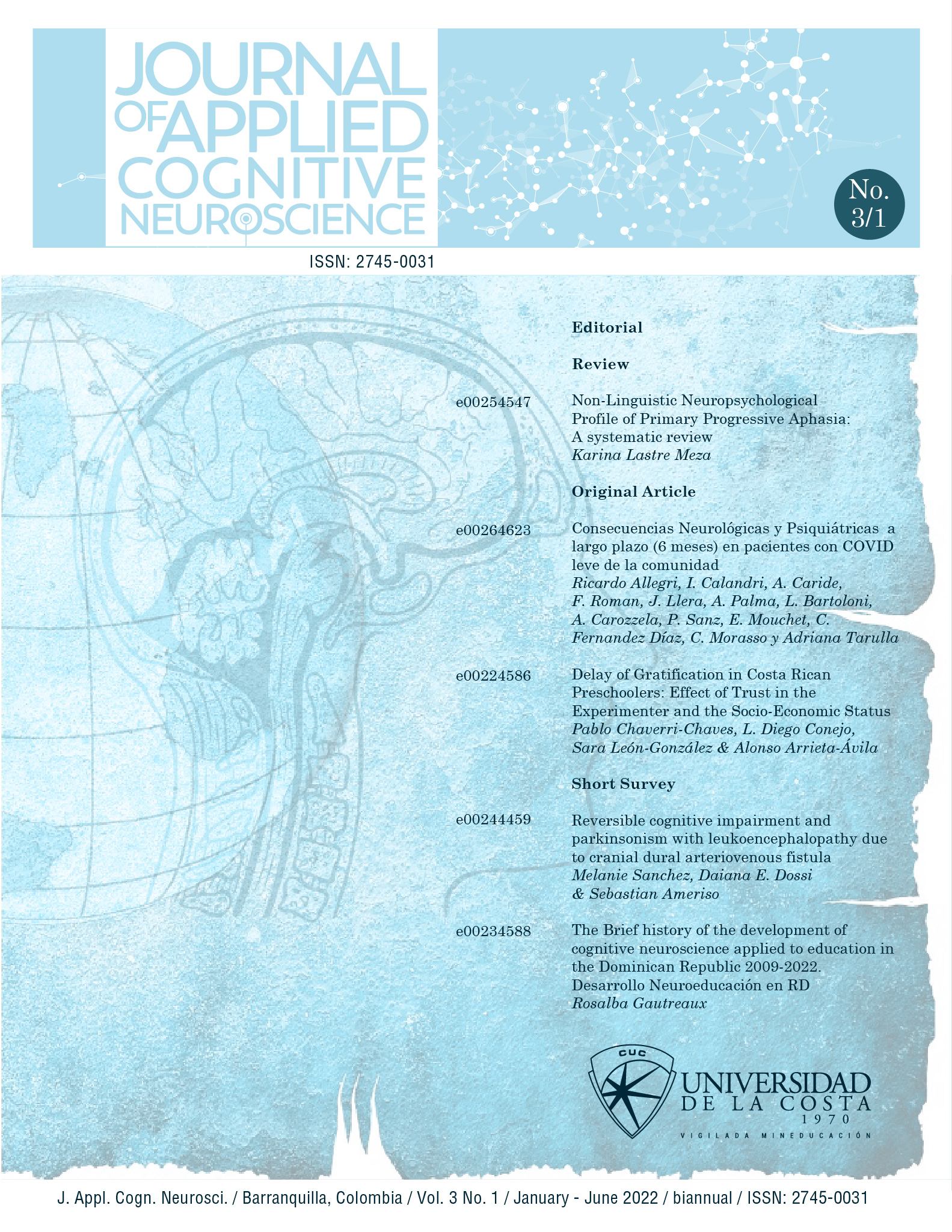Reversible cognitive impairment and parkinsonism with leukoencephalopathy due to cranial dural arteriovenous fistula
Deterioro cognitivo reversible y parkinsonismo con leucoencefalopatía por fístula arteriovenosa dural craneal
DOI:
https://doi.org/10.17981/JACN.3.1.2022.05Keywords:
cognitive impairment, parkinsonism, dural arteriovenous fistula, leukoencephalopathyAbstract
Parkinsonism and rapid cognitive impairment may have many causes, but only a few have specific treatment. Cranial dural arteriovenous fistula (DAVF) represents 10-15% of intracranial arteriovenous malformations. Clinical manifestations depend on location and venous drainage. It is common the presence of pulsatile tinnitus, bruits and headache or headache and papilledema. Progressive cognitive decline is an unusual presentation due to bilateral thalamic edema or cortical venous hypertension. Endovascular or surgical treatment can reverse disease symptoms.
We present a 74-year old man with rapidly progressive cognitive impairment and parkinsonism and a subsequent diagnosis of dural arteriovenous fistula (DAVF). Brain MRI revealed diffuse leukoencephalopathy probably attributable to elevated venous pressure. He was treated with partial embolization with Onix and left transverse sinus angioplasty. Following the procedure, there was a substantial reduction of venous pressure signs and remarkable clinical and imaging improvement, persisting at two years follow-up. This case represents an unusual presentation of DAVF. It is important to suspect the diagnosis of DAVF in cases with rapidly evolving cognitive impairment, parkinsonism and leukoencephalopathy as it can be reversible with early treatment.
Downloads
References
Brinjikji, W.; Cloft, H. J. & Lanzino, G. (2020). Clinical Presentation and Imaging Findings of Patients with Dural Arteriovenous Fistulas with an Angiographic Pseudophlebitic Pattern. AJNR Am J Neuroradiol.
http://dx.doi.org/10.3174/ajnr.A6811
Brito, A.; Tsang, A. C.-O.; Hilditch, C.; Nicholson, P.; Krings, T. & Brinjikji, W. (2018). Intracranial Dural Arteriovenous Fistula as a Reversible Cause of Dementia: Case Series and Literature Review. World Neurosurg.
Elhammady, M. S.; Ambekar, S. & Heros, R. C. (2017). Epidemiology, clinical presentation, diagnostic evaluation, and prognosis of cerebral dural arteriovenous fistulas. Handbook of Clinical Neurology, 143 (3 series).
Geraldes, R.; Albuquerque, L.; Ferro, J. M.; Sousa, R.; Sequeira, P. & Campos, J. (2012). Rapidly Progressive Cognitive Impairment, Ataxia,and Myoclonus: An Unusual Presentation of a Dural Arteriovenous Fistula. Journal of Stroke and Cerebrovascular Diseases, 21(7), 619.e3–619.e5
Luo, Y. et al. (2014). Two cases of dural arteriovenous fistula presenting with parkinsonism and progressive cognitive dysfunction, J Neurol Sci
http://dx.doi.org/10.1016/j.jns.2014.05.059
Nasreddine et al. (2005). The Montreal Cognitive Assessment, MoCA: A Brief Screening Tool For Mild Cognitive Impairment. Journal of American Geriatrics Society.
Netravathi, M.; Pal, P. K.; Bharath, R. D. & Ravishankar, S. (2010). Intracranial dural arteriovenous fistula presenting as parkinsonism and cognitive dysfunction. Case Reports. Journal of Clinical Neuroscience 18 (2011) 138–140.
http://doi.org/10.1016/j.jocn.2010.04.047
Racine, C. A.; Lawton, M. T.; Hetts, S. W. & Josephson, S. A. (2008). Neuropsychological Profile of Reversible Cognitive Impairment in a Patient with a Dural Arteriovenous Fistula, Neurocase: The Neural Basis of Cognition, 14(3), 231–238.
http://doi.org/10.1080/13554790802232677
Waragaia, M.; Takeuchib, H.; Fukushimaa, T.; Haisac T. & Yonemitsuc, T. (2006). MRI and SPECT studies of dural arteriovenous fistulas presenting as pure rogressive dementia with leukoencephalopathy: a cause of treatable dementia. EFNS European Journal of Neurology 13, 754–759
Yamakami, I.; Kobayashi, E. & Yamaura, A. (2001). Diffuse white matter changes with dementia caused by dural arteriovenous fistula:report of two cases. Journal of Clinical Neuroscience, 8(5), 471–475 © 2001 Harcourt Publishers Ltd http://doi.org/10.1054/jocn.2000.0796.
Published
How to Cite
Issue
Section
License
Copyright (c) 2022 Journal of Applied Cognitive Neuroscience

This work is licensed under a Creative Commons Attribution-NonCommercial-NoDerivatives 4.0 International License.
You are free to:
- Share — copy and redistribute the material in any medium or format.
- The licensor cannot revoke these freedoms as long as you follow the license terms.
Under the following terms:
- Attribution — You must give appropriate credit, provide a link to the license, and indicate if changes were made. You may do so in any reasonable manner, but not in any way that suggests the licensor endorses you or your use.
- NonCommercial — You may not use the material for commercial purposes.
- NoDerivatives — If you remix, transform, or build upon the material, you may not distribute the modified material.
- No additional restrictions — You may not apply legal terms or technological measures that legally restrict others from doing anything the license permits.


 English
English
 Español (España)
Español (España)










